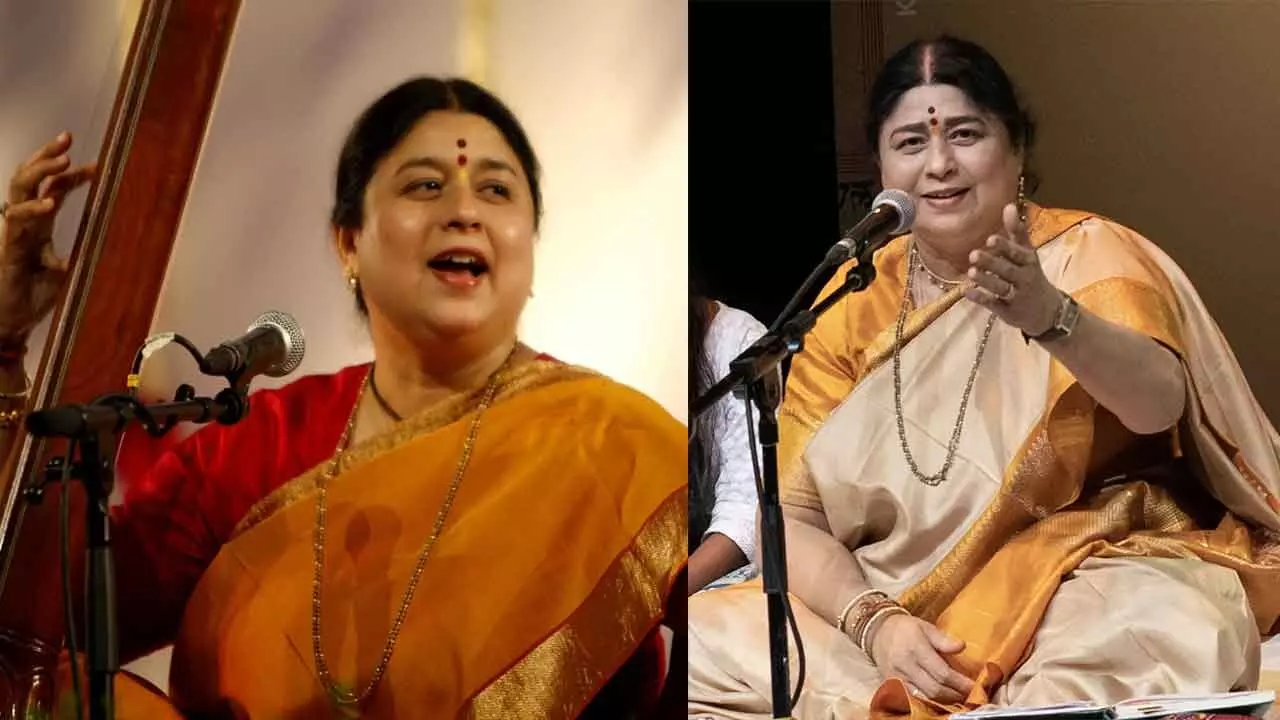Live
- Public Participation Key to Strengthening Democracy-Annamalai
- MLA Anirudh Reddy gets threat letter from Maoist
- "Awareness Program on Road Safety for Auto Drivers Held in Aija Town".
- MLA Bandla Krishna Mohan Reddy Inaugurates NPL Season-4 Cricket Tournament in Netivanipalli
- Rangoli Competitions Showcase Tradition and Creativity in Gadwal.
- "Vadde Obanna: A Revolutionary Hero’s Legacy Celebrated on His 218th Birth Anniversary".
- District Administration Accelerates Implementation of Welfare Schemes.
- Illegal Transportation of Gravel and Soil in Sankalmaddi Village Raises Concerns
- Weavers Celebrate Telangana CM Revanth Reddy’s Welfare Initiatives with Milk Ablution in Aiza.
- MLA Couple Attends Oath-Taking Ceremony of New Governing Body at Shri Shri Jamulamma Parashurama temple in Jammi chedu.
Just In

Kalapani Komakali, a distinguished classical vocalist and daughter of legends Pandit Kumar Gandharva and Vidushi Vasundhara Komakali, carries forward a rich musical legacy. Known for her soulful renditions, she blends technical mastery with deep emotional expression
Endowed with a uniquely rich and melodious voice, Kalapani Komakali is celebrated as one of India's finest classical vocalists. As the daughter and disciple of the legendary Pandit Kumar Gandharva and Vidushi Vasundhara Komkali, she embodies a legacy of musical excellence. Kalapini not only learned the techniques of her art from her distinguished parents but also inherited a capacity for creativity and reflection.
Her performances are marked by youthful imagination and artistic thoughtfulness, showcasing a mature command of classical vocalism. Emphasizing the emotional depth of her renditions, Kalapini masterfully balances the intricacies of the bandish (composition) and its bhava (meaning), ensuring that neither the notes nor the tempo overshadow the lyrics. With a versatile vocal range, she conveys a spectrum of emotions through her music. Rooted in the Gwalior gayaki, her improvisations reflect her distinct artistic identity.
Kalapini's extensive repertoire includes traditional Malwa folk songs and the Sagun-Nirgun bhajans (devotional songs) of various saint poets, adding an ascetic quality to her music. Under the auspices of Kumar Gandharva Pratishthan, she has organised music festivals across India, uniting scholars, performers, and young artists. Her engaging lecture-demonstrations have made her a beloved figure among the youth.
Kailas Sangeet trust is organising ‘Acharya Devo Bhava’ to celebrate the birth centenary of Acharya Pt Bimalendu Mukherjee. Could you share your thoughts on being part of it?
It’s a privilege to celebrate the centenary of Pandit Bimalendu Mukherjee. His title, ‘Acharya Devo Bhava’, reflects his mastery of sitar and deep knowledge. I am grateful for this opportunity to perform and pay homage to such a respected figure.”
Could you share a bit about the preparation process for all these upcoming performances?
I am always mindful of the audience and organisers. Understanding their expectations is crucial, especially for a performance honouring Acharya Bimalendu Mukherjee. This is a significant moment for me, and I strive to present my best.
How do you feel performing in Hyderabad?
Hyderabad feels welcoming, and I cherish the opportunity to reconnect with its people. Music is a dialogue, and performing here will allow me to interact with the audience, making it a special experience.
Any valuable musical lessons or advice from your Guru that you can share with us?
My parents, Pandit Kumar Gandharva and Vidushi Vasundhara Komkali, taught me the essence of music. Their guidance instilled in me not just technical skills but a profound understanding of artistic expression.
What role do you think organisations like Kailas Sangeet trust play in sustaining our classical music?
Organisations like Kailasa Sangeet Trust are vital for sustaining classical music. They educate listeners and create meaningful content through concerts, fostering a deeper appreciation for our musical heritage.
Quote: “One of the defining aspects of classical music is its inherent uncertainty. To truly engage with it, one must approach it wholeheartedly, embracing the unpredictability that comes with it. You can't control the outcome; instead, you must take the risk and play the gamble. This uncertainty is invaluable, whether it pertains to the conception of a composition, a raga, or the overall presentation. Unlike a craftsman, who can plan precisely and replicate performances, an artist navigates a different terrain. While they may have a general idea, the specifics of their delivery remain elusive until the moment unfolds. This unpredictability is one of the most challenging yet rewarding aspects of Indian classical music, highlighting its emotional depth and artistic expression.”- Kalapani Komakali

© 2025 Hyderabad Media House Limited/The Hans India. All rights reserved. Powered by hocalwire.com







